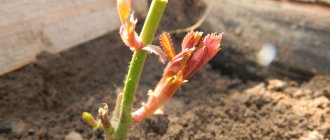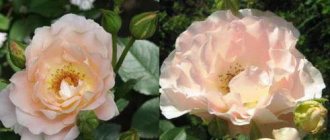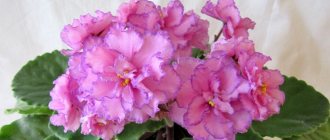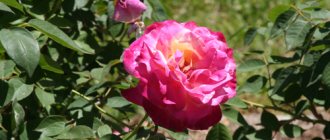The color variety of hybrid tea roses can be described indefinitely - one-color, two-, three-color. But looking at this particular beauty, it is impossible to unambiguously describe its color - the color changes depending on the transition from one stage of flowering to the next. The name of this phenomenal person is Aqua, which means “water.” The name is very suitable for the variety, because its color also easily flows from one tone to another, like flowing water.
Description of the species
The “aqua” rose variety was bred in Holland and belongs to the Rosaceae family, a variety of hybrid tea roses. The flower has a pure pink color. It is distinguished by a large number of shades - from pale pink to rich lilac-pink. Flowering is observed from the first month of summer until frost.
The buds are quite large, 8-12 cm, double, with dense petals, located on long stems, and have a very pleasant, memorable smell. This variety is characterized by the coloring of the petals from lighter at the base to darker at the edges. Interestingly, the color of the flower changes as the flowering stages progress. Gradually it fades from sunlight and the color becomes pale blue.
This variety tolerates frosts down to -10 ºС and is relatively resistant to diseases and pests. For the winter it must be protected from the cold.
History of creation
The exact date when the variety was introduced is not found in Internet sources. The variety was bred by Dutch breeders for commercial use and is classified as a cut flower. Selection of the Schreurs company (Petrus Nicolaas Johannes), the Netherlands. The name under which the new product has become widely known, Aqua!®, is a patented trademark. The unique code of the rose is SCHrenat. As a cut crop, Aqua is grown in many countries and is incredibly popular. She is a participant in many exhibitions, in particular the Flowers Expo held in Moscow, and has an award from the Syracuse Rose Society in the Show category.
Features of hybrid tea varieties of roses
In their homeland, hybrid tea roses are called large-flowered. They have become a real event in the floriculture world due to their qualities and beauty. Over the 100-year history of existence and breeding, such varieties have become very popular and widespread among amateurs and professionals.
The main advantage of hybrid tea varieties is long and continuous flowering throughout the warm season, and in the greenhouse even in the colder months. In total, there are about 100 such varieties in the world, with a wide variety of colors: from white and yellow to pink and burgundy.
The hybrid tea rose “aqua” is one of the most beautiful representatives of this species. It grows on a bush up to 0.8-1.2 m high, which has strong, even stems that are almost devoid of thorns.
Application in landscape design
Rose Aqua is widely used in landscape design. The following plants should be chosen as companions:
- bluebell, delphinium and sage;
- Veronica, lavender, anafalis;
- asters, spurge.
Select the color scheme of plants at your discretion.
Use Cases
The Aqua variety of rose is most often grown commercially. The variety is used for bouquets and retains freshness for up to 10 days. The shrub is used in single plantings in the middle of the site, near the facade of a building or fence.
The rose is suitable for mixed borders; it is clearly visible among dense thickets. The variety is suitable for ridges and mixborders. Combines with annual crops in purple, white, and blue shades. The rose can be planted next to miniature coniferous trees, other roses, and various herbs.
Planting and care
Caring for rose bushes will not be difficult even for amateurs and novice gardeners. Those of them who have been involved in growing the “aqua” rose variety always give positive reviews, full of delight at the beauty and smell of this delicate flower.
The first year after planting is of great importance, when growth, development, establishment and flowering occur. Rose bushes are planted either in autumn (no later than a month before frost) or in April-May. To do this, select a sunny or partial shade place, preferably protected from the wind, for example, under the cover of a wall on the north side.
For a seedling 30 cm high, you need to dig a hole up to 0.4 m deep and put drainage at the bottom. The bush should be planted in a mixture of soil and humus, and also add fertilizer. The distance between crops can be about 0.5 m. The rose bush is planted in the spring so that the grafting site is 3 cm lower than the soil surface.
This variety is grown both in open ground and in greenhouses. The basic rules for caring for the “aqua” rose variety include regular watering, fertilizing, removing weeds, and ensuring disease prevention.
Growing a flower
If you follow the key rules of agricultural technology, the shrub will certainly take root in a new place and demonstrate everything it is capable of.
Seedlings are purchased from nurseries and garden centers, where supplies are made from the Cordes branded network. Considering that the tea hybrid does not produce full-fledged seeds, seed sowing for propagation is impossible, only by grafting.
Autumn planting shows the best results. The time is selected depending on the climate, counting 3 weeks until the next frost. At this moment, the leaves are already preparing to fall, but the roots are still active enough to start growing in a new place.
Selecting a location
Preference is given to open areas on a small hill, well ventilated. This is a mandatory condition, since this rose has low resistance to fungal diseases. If planting is carried out in the southern region, then choose a place in partial shade so that sunburn does not appear on the petals.
How to prepare the soil and flower for planting
Black soil is ideal, but loam is also suitable, as long as the groundwater level is low enough. Acidity range pH=5.6-7.3. On acidic soils, preliminary liming is required, and peat is added to clay soils.
The climbing rose Abracadabra for spring planting should only have dormant buds, but for autumn planting it may have foliage and even buds that will have to be cut off immediately. The root system of seedlings without shipping containers needs to be soaked for 6 hours.
Step by step landing procedure
Landing is done like this:
- Planting holes are dug to a depth of 50 cm and at the same distance from each other.
- A layer of 5-10 cm of drainage is poured onto the bottom (sand mixed with agroperlite, vermiculite or small crushed stone, expanded clay).
- The soil is mixed with humus or compost, adding 40-50 g of superphosphate.
- The roots are lowered into the hole, deepening the root collar by 3-5 cm.
- Cover with soil and water immediately.
- Mulching.
Plant nutrition
As a top dressing, slurry is most often used, which contains the necessary chemical elements, as well as beneficial bacteria. It is the latter that convert compounds inaccessible to plants into a form that is perfectly absorbed by them.
Feeding is done once every 2 weeks, and during the summer season only 3-4 times (from the end of June to August). Mullein must first be prepared, for which it is placed in a barrel with water in a ratio of 1:3 1.5-2 weeks before use. Chemical fertilizers are also added to this mixture: potassium sulfate and double superphosphate (calculated at 15 g per 10 liters of water).
The finished infused concentrate is diluted with water in a ratio of 1:10. Furrows are made around the bush at a distance of 35-40 cm, into which water is first poured, and then the resulting composition with mullein is poured. 3-5 liters are added to each bush, then the furrows are filled with soil or sand, the next day the soil should be loosened.
Also in the spring, complex mineral fertilizer is applied along with ammonium nitrate, and in the autumn, fertilizing with potassium and phosphorus is done.
Watering and flowering
Rose "aqua" needs frequent regular watering, 3-4 times a week is enough. In this case, it is necessary to ensure that the soil does not become waterlogged and water does not fall on the leaves. The best time for watering is early in the morning, after which the soil should be well loosened to a depth of 4-5 cm. This will provide air access to the roots. After watering, it is necessary to mulch to avoid overheating.
Excessive flowering in the first year of the plant’s life is not recommended, as this will result in the formation of too large a root system. Small buds that appear in the first half of summer should be removed immediately. In August, you can leave 1-2 flowers, which will allow the plant to prepare for the cold weather.
Step-by-step instructions: how to propagate?
Aqua roses are easiest to propagate by dividing the bushes . The method is suitable for specimens grown by rooting cuttings, layering or dividing the bush. The event is held in early spring.
After the ground has completely thawed, but the buds have not yet appeared, dig up a mature bush. If the mother plant needs to be saved, only the peripheral part can be separated with a shovel.- Disinfect the pruning shears. Carefully divide the bush into parts, each of which should have roots and one shoot.
- Trim damaged roots to healthy parts.
- Shorten the shoots by 2/3, leaving 3-4 buds on each. The top remaining buds should not be directed inward.
- Dip the roots into a clay mash.
- Plant the bushes in the soil in the usual way with a depth of 5 cm.
- Water generously. Spud up.
The reader may be interested in articles about other varieties of roses. Read on our portal about the roses Empress Farah, Rugosa, Double Delight, Cordesa, Abraham Derby, Chippendale, William Shakespeare, Graham Thomas, Flamentanz, Cordana Mix.
Shelter for winter and spring work
In autumn, when the temperature begins to drop below zero, young rose bushes must be covered. Otherwise, they will freeze and may die. For protection, dry soil or sand is used, which is used to hill up the bush to a height of 30 cm, and spruce branches are also placed on top.
In the spring, as soon as fresh shoots begin to appear, all shelters are removed in stages, 8-10 times. It is best to do this in cloudy weather or in the evening so that the sun's rays do not damage the shoots. After removing the last layer, it is recommended to cover the young branches again with spruce branches from the sun.
Immediately after removing the covering layer and freeing the branches, the bush should be pruned.
Diseases and pests
When growing aqua roses, like all representatives of hybrid tea varieties, gardeners most often encounter fungal diseases. Their causative agents are parasitic fungi that feed on the substances that the bush receives. They spread due to high humidity and heat. Nitrogenous fertilizers often promote their development. They reproduce very quickly by airborne spores.
Common diseases:
- Rust. Usually moves to rose bushes from a nearby juniper tree. To avoid infection, bushes should not be planted nearby.
- Powdery mildew (downy mildew). Often found in rainy summers, it appears as red or brown mold. To prevent this disease, bushes need to be planted in places where air circulates well. Affected leaves should be destroyed immediately. Along with powdery mildew, aphids often coexist. To combat it, plants are sprayed with a solution of alcohol and laundry soap.
- Gray rot. Affecting leaves and flowers, it forms a gray coating. Decaying parts of the plant turn black and die. To combat it, the bushes are sprayed with horsetail decoction. All diseased parts should be removed.
Pests of pink aqua rose bushes are caterpillars and larvae that actively eat leaves, shoots and roots:
- Leaf roller. It eats all the green parts of the plant and entangles it in cobwebs. All affected parts must be removed, and the bushes are treated with insecticides.
- Moths. These green caterpillars love to eat shoots and leaves. After their detection, the plant must be treated.
- Spider mites. They settle on the plant, sucking its juices. After this, the bush turns yellow and dies. Spider mites often appear during dry periods.
- Nematodes. Worms live on the roots of the rose bush. They can only be destroyed together with the diseased plant. Then calendula or other flowers are planted in this place, which repel nematodes.
Main characteristics
Rose “watercolor”: description of the variety, photos and reviews
For ease of reference, the key features of the variety are presented in the table:
| Parameter | Characteristic |
| Culture | Rose (Rosa L.) |
| Variety | "Aqua" (Aqua!, Schrenat) |
| Garden group | Hybrid Tea (Hg) / Hybrid Tea (HT) / Cutting (Florists Rose) |
| Form | Bush |
| Life cycle | perennial |
| Purpose | Cutting, decorative |
| Reproduction | Vegetative (cuttings, grafting) |
| Bush height | 50-90 cm (up to 120) |
| Flowering type | Reblooming |
| Flowering period | June – October |
| Type of flower | Terry |
| Number of petals | 35-45 pcs. |
| Flower diameter | 9-12 cm |
| Petal coloring | Pink, pink-lilac |
| Disease resistance | Average |
| Frost resistance | Up to −23 ℃ |
| Registration in the State Register of the Russian Federation | Absent |
Flowers on the bush last a very long time, flowering continues until the onset of persistent frosts.
Roses and perfumes
Charming pink aromas of love have been used to create perfumes since ancient times. Nowadays, several hundred varieties of roses are successfully used to create perfumes or eau de toilette. They are used to make oil, water, or a solid extract called “rose concrete.”
The recognized capital of perfume is Paris. France has been cultivating rose plantations specifically for the creation of such products for several centuries.
“Aqua Allegory Rose” is one of the fragrances in the Guerlain line, which was first introduced to the public back in 1999. When creating this perfume series, its founder, Jean Paul Guerlain, dreamed of expressing his passionate love for natural garden scents.
“Aqua Allegory Flora Rose” is one of the bright floral fragrances from the Guerlain series. It was released in 2013 and combined the scents of roses, red berries, iris and musk.
Many women love very feminine and delicate flower scents. Therefore, these notes are present in almost every perfume product.











